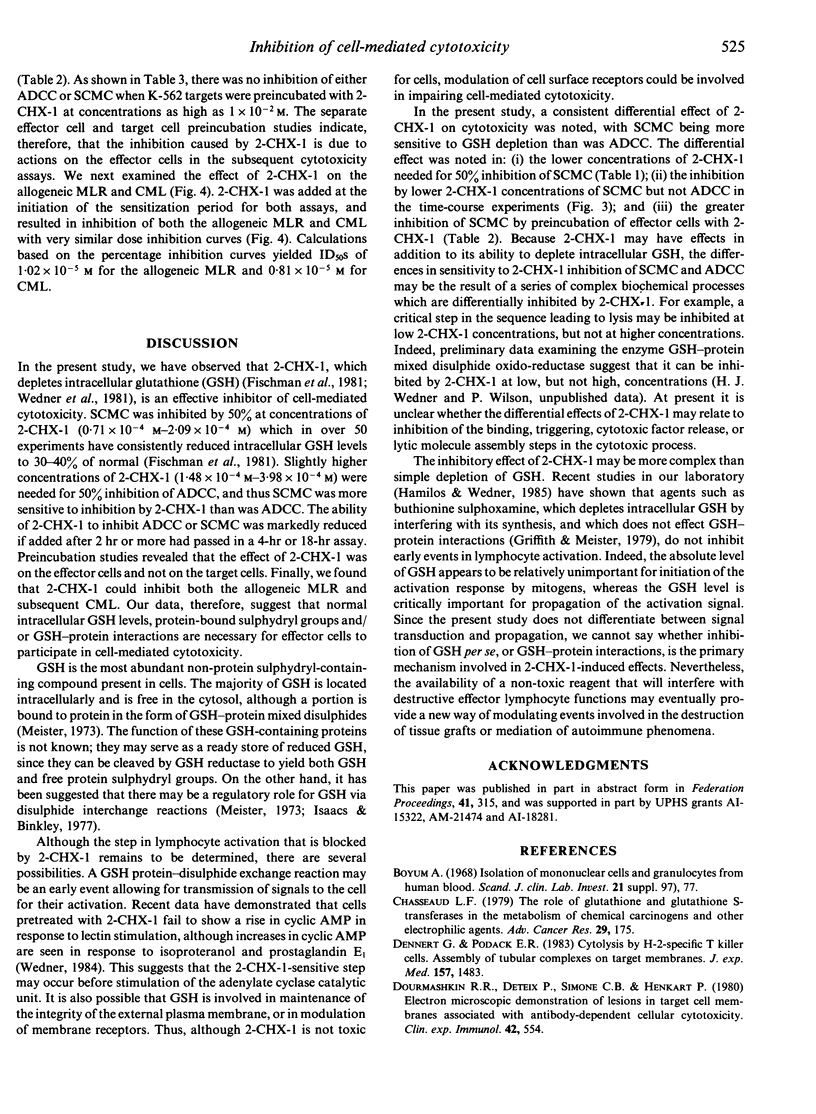Abstract
In order to explore the role of glutathione in cell-mediated cytotoxicity, we have examined the effect of the sulphydryl-reactive and glutathione-depleting agent 2-cyclohexene-1-one on antibody-dependent cellular cytotoxicity, spontaneous cell-mediated cytotoxicity, and cell-mediated lympholysis by human peripheral blood mononuclear cells. 2-Cyclohexene-1-one significantly inhibited (P less than 0.001) both antibody-dependent and spontaneous cell-mediated cytotoxicity using three different cell-line targets, at three different killer:target cell ratios (10:1, 25:1 and 50:1). Using K-562 cell-line targets, spontaneous cell-mediated cytotoxicity was inhibited by 2-cyclohexene-1-one with an ID50 of 0.71 X 10(-4) M-1.48 X 10(-4) M, while antibody-dependent cellular cytotoxicity was less sensitive to inhibition, and required slightly higher concentrations of 1.48 X 10(-4) M-3.98 X 10(-4) M to achieve 50% inhibition. Similar results were seen with human colon tumour cell-line and Chang liver cell-line cells as targets. Maximal inhibition occurred when 2-cyclohexene-1-one was added to the cytotoxicity assay 60 min prior to, at the start of, or within the first 60 min of a 4-hr assay; inhibition of cytotoxicity occurred with pretreatment of effector cells; and no inhibition of cytotoxicity was observed with pretreatment of target cells. Both the allogeneic mixed leucocyte reaction and cell-mediated lympholysis were also significantly inhibited (P less than 0.001) by 2-cyclohexene-1-one. These studies demonstrate that 2-cyclohexene-1-one is an effective inhibitor of cell-mediated cytotoxicity and suggest that glutathione, specific glutathione-protein interactions, or protein-bound sulphydryl groups are involved in allowing cells to carry out cytolysis.
Full text
PDF





Selected References
These references are in PubMed. This may not be the complete list of references from this article.
- Chasseaud L. F. The role of glutathione and glutathione S-transferases in the metabolism of chemical carcinogens and other electrophilic agents. Adv Cancer Res. 1979;29:175–274. doi: 10.1016/s0065-230x(08)60848-9. [DOI] [PubMed] [Google Scholar]
- Dennert G., Podack E. R. Cytolysis by H-2-specific T killer cells. Assembly of tubular complexes on target membranes. J Exp Med. 1983 May 1;157(5):1483–1495. doi: 10.1084/jem.157.5.1483. [DOI] [PMC free article] [PubMed] [Google Scholar]
- Dourmashkin R. R., Deteix P., Simone C. B., Henkart P. Electron microscopic demonstration of lesions in target cell membranes associated with antibody-dependent cellular cytotoxicity. Clin Exp Immunol. 1980 Dec;42(3):554–560. [PMC free article] [PubMed] [Google Scholar]
- Farram E., Targan S. R. Identification of human natural killer soluble cytotoxic factors (NKCF) derived from NK-enriched lymphocyte populations: specificity of generation and killing. J Immunol. 1983 Mar;130(3):1252–1256. [PubMed] [Google Scholar]
- Fischman C. M., Udey M. C., Kurtz M., Wedner H. J. Inhibition of lectin-induced lymphocyte activation by 2-cyclohexene-1-one: decreased intracellular glutathione inhibits an early event in the activation sequence. J Immunol. 1981 Dec;127(6):2257–2262. [PubMed] [Google Scholar]
- Griffith O. W., Meister A. Potent and specific inhibition of glutathione synthesis by buthionine sulfoximine (S-n-butyl homocysteine sulfoximine). J Biol Chem. 1979 Aug 25;254(16):7558–7560. [PubMed] [Google Scholar]
- Hamilos D. L., Wedner H. J. The role of glutathione in lymphocyte activation. I. Comparison of inhibitory effects of buthionine sulfoximine and 2-cyclohexene-1-one by nuclear size transformation. J Immunol. 1985 Oct;135(4):2740–2747. [PubMed] [Google Scholar]
- Henkart M. P., Henkart P. A. Lymphocyte mediated cytolysis as a secretory phenomenon. Adv Exp Med Biol. 1982;146:227–247. doi: 10.1007/978-1-4684-8959-0_13. [DOI] [PubMed] [Google Scholar]
- Henkart P. A., Millard P. J., Reynolds C. W., Henkart M. P. Cytolytic activity of purified cytoplasmic granules from cytotoxic rat large granular lymphocyte tumors. J Exp Med. 1984 Jul 1;160(1):75–93. doi: 10.1084/jem.160.1.75. [DOI] [PMC free article] [PubMed] [Google Scholar]
- Hiserodt J. C., Britvan L., Targan S. R. Studies on the mechanism of the human natural killer cell lethal hit: analysis of the mechanism of protease inhibition of the lethal hit. J Immunol. 1983 Dec;131(6):2705–2709. [PubMed] [Google Scholar]
- Isaacs J., Binkley F. Glutathione dependent control of protein disulfide-sulfhydryl content by subcellular fractions of hepatic tissue. Biochim Biophys Acta. 1977 Mar 29;497(1):192–204. doi: 10.1016/0304-4165(77)90152-0. [DOI] [PubMed] [Google Scholar]
- Podack E. R., Dennert G. Assembly of two types of tubules with putative cytolytic function by cloned natural killer cells. 1983 Mar 31-Apr 6Nature. 302(5907):442–445. doi: 10.1038/302442a0. [DOI] [PubMed] [Google Scholar]
- Sondel P. M., Chess L., MacDermott R. P., Schlossman S. F. Immunologic functions of isolated human lymphocyte subpopulations. III. Specific allogeneic lympholysis mediated by human T cells alone. J Immunol. 1975 Mar;114(3):982–987. [PubMed] [Google Scholar]
- Targan S. R., Newman W. Definition of a "trigger" stage in the NK cytolytic reaction sequence by a monoclonal antibody to the glycoprotein T-200. J Immunol. 1983 Sep;131(3):1149–1153. [PubMed] [Google Scholar]
- Trinchieri G., Perussia B. Human natural killer cells: biologic and pathologic aspects. Lab Invest. 1984 May;50(5):489–513. [PubMed] [Google Scholar]
- Wedner H. J. Biochemical events associated with lymphocyte activation. Surv Immunol Res. 1984;3(4):295–303. doi: 10.1007/BF02919047. [DOI] [PubMed] [Google Scholar]
- Wedner H. J., Simchowitz L., Stenson W. F., Fischman C. M. Inhibition of human polymorphonuclear leukocyte function by 2-cyclohexene-1-one. A role for glutathione in cell activation. J Clin Invest. 1981 Aug;68(2):535–543. doi: 10.1172/JCI110285. [DOI] [PMC free article] [PubMed] [Google Scholar]
- Wright S. C., Bonavida B. Studies on the mechanism of natural killer (NK) cell-mediated cytotoxicity (CMC). I. Release of cytotoxic factors specific for NK-sensitive target cells (NKCF) during co-culture of NK effector cells with NK target cells. J Immunol. 1982 Jul;129(1):433–439. [PubMed] [Google Scholar]


